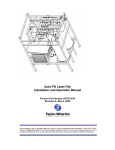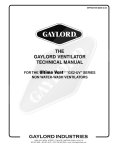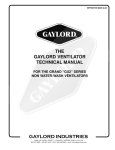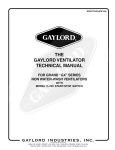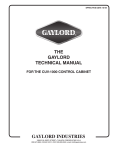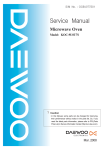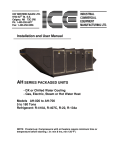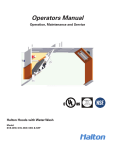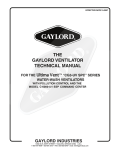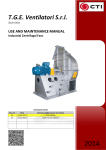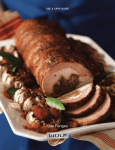Download RSPC TPF tm
Transcript
Effective Date: 4-05 TECHNICAL MANUAL FOR INSTALLATION, OPERATION AND MAINTENANCE OF THE GAYLORD "ClearAirTM" MODEL "RSPC-TPF" SERIES POLLUTION CONTROL UNITS WITH FM-100 SERIES MONITORING STATION WARNING Improper installation, adjustment, alteration service or maintenance can cause property damage, injury or death. Read the installation, operation and maintenance instructions thoroughly before installing or servicing this equipment. Only trained and qualified service personnel should install or service this equipment. GAYLORD INDUSTRIES 10900 S.W. AVERY STREET • TUALATIN, OR 97062-1149 USA PHONE: 503-691-2010 • TOLL FREE: 800-547-9696 • FAX: 503-692-6048 email:[email protected] • www.gaylordusa.com GAYLORD INDUSTRIES “Undisputed World Leader in Engineered Systems for Commercial Kitchens”tm World Headquarters: 10900 S.W. Avery Street • Tualatin, Oregon 97062-1149 U.S.A. To Our Customers. . . Congratulations on your recent purchase of a Gaylord ClearAirTM Pollution Control Unit. We are proud to be able to provide you with a quality product that exemplifies our long-standing dedication to quality engineering. Your unit is assembled from some of the very finest components available and is designed for years of efficient, effective, and troublefree operation. In addition, this unit has undergone rigorous quality control inspections and was fully operationally tested prior to shipment. If you have further questions, please contact us toll free at 1-800-547-9696, or [email protected]. We are more than happy to help. Sincerely, Gaylord Industries STREET ADDRESS: 10900 S.W. Avery Street, Tualatin, Oregon 97062-8549 U.S.A. PHONE: 503-691-2010 • 800-547-9696 • FAX: 503-692-6048 • email: [email protected] • www.gaylordusa.com COMMERCIAL KITCHEN EXHAUST SYSTEMS • FIRE PROTECTION • HEAT RECLAIM • UTILITY DISTRIBUTION • ROOF TOP UNITS • POLLUTION CONTROL • AIR HANDLING UNITS 2 TECHNICAL MANUAL FOR INSTALLATION, OPERATION AND MAINTENANCE OF THE GAYLORD “ClearAirTM” MODEL “RSPC-TPF” SERIES POLLUTION CONTROL UNITS WITH FM-100 SERIES MONITORING STATION Published by: GAYLORD INDUSTRIES Tualatin, Oregon 97062-1149 U.S.A. First Printing: January, 2003 © Copyright 2005, Gaylord Industries ALL RIGHTS RESERVED. NO PART OF THIS BOOK MAY BE REPRODUCED, STORED IN A RETRIEVAL SYSTEM, OR TRANSMITTED IN ANY FORM BY AN ELECTRONIC, MECHANICAL, PHOTOCOPYING, RECORDING MEANS OR OTHERWISE WITHOUT THE WRITTEN PERMISSION OF GAYLORD INDUSTRIES, INC. COPYRIGHT 2003. The manufacturer reserves the right to modify the materials and specifications resulting from a continuing program of product improvement or the availability of new materials. Additional Copies $15.00 TM The Gaylord ClearAir Unit is designed and engineered by GAYLORD INDUSTRIES 10900 S.W. Avery Street, Tualatin, Oregon 97062-1149. 3 TABLE OF CONTENTS INTRODUCTION .......................................................................................... 5 SPECIFICATIONS .................................................................................... 6-7 MODEL NUBER EXPLANATION ................................................................. 8 TYPICAL INSTALLATION ............................................................................. 9 SAMPLE ClearAir TM CONFIGURATIONS ............................................. 10-11 RECEIVING & INSTALLATION ................................................................... 12 EQUIPMENT LIFTING PROCEDURE ........................................................ 13 ASSEMBLING RSPC HOUSING ON UNITS SPLIT FOR SHIPMENT ....14-15 FM-100 MONITORING STATION (PARTS) ............................................ 16-17 ODOR CONTROL SECTION ................................................................18-21 EXHAUST FAN SECTION .................................................................... 22-23 NAMEPLATE DATA ................................................................................... 24 OPERATING MATRIX ................................................................................ 25 PRESSURE SWITCH TUBING DIAGRAM ................................................. 26 MAINTENANCE ......................................................................................... 27 FM-100 TERMINAL VOLTAGES ................................................................ 28 WIRING DIAGRAM ..................................................................................... 29 PARTS-MISCELLANEOUS ...................................................................... 30 START-UP INSTRUCTIONS....................................................................... 31 CLEARAIR RSPC-TPF START-UP INSPECTION REPORT ...................... 32 WARRANTY ........................................................................ Inside back cover 4 INTRODUCTION A Other more technical methods of determining opacity or particulate density are achieved through the use of opacity meters and cascade impactors. This level of analysis is usually referred to as source testing. Control agencies occasionally require this type of analysis and if so, the testing is conducted by state certified contractors which can be quite costly and time-consuming. The efficiency of an TPF is based on how well it reduces the opacity level of a given airstream.The Gaylord ClearAirTM unit will reduce the opacity level below Pollution control in kitchen exhaust systems has typically been 20%, thereby meeting the requirements of environmental conaccomplished by any one of the following methods - gas fired trol agencies. incinerators, scrubbers, filtration units or electrostatic precipitators. Incinerators and afterburners literally burn the pollutants Basic Facts About Odor and, while effective, can be very costly and hazardous to oper- Cooking odors (molecules) generated by the combustion of ate. Scrubbers consist of a water bath and extraction baffles to animal and vegetable matter result in an extremely complex remove the pollutants and though quite effective on grease re- mixture of reactive organic gases (ROG’s). A small percentage of moval, they typically require the addition of high efficiency fil- these odors may be absorbed by the grease particles but the ters to abate smoke below control agencies’ standards. Filtra- vast majority exist separately in the airstream. The ROG moltion units use a series of impingement filters to remove the ecules are much too small to be removed by any type of filter and pollutants and if done properly can be quite effective on both therefore, other methods must be used. There are several methods with which to manage the odor. One method is to use a smoke and grease. media bed. The two most popular types of media bed are actiTM TM The Gaylord pollution control unit, trademarked “ClearAir ” , vated charcoal, which absorbs and retains the odor molecules, can be manufactured with either electrostatic precipitation and the use of an odor-oxidant media (potassium permangan(ESP) or Filtration (TPF). Gaylord Industries, Inc. has been ate) which oxidizes the molecules to solids and then retains them. manufacturing ESP’s specifically designed for commercial The other method involves the use of a liquid delivered with a finely kitchen exhaust systems since the early 1970’s, longer than atomized spray. This spray performs a similar function to potasany other manufacturer. However, when initial cost is a greater sium permanganate in that it adsorbs or chemically neutralizes concern the TPF unit is a sound alternative. odors. This process has the benefit of the end user being able to The ClearAirTM TPF unit is available in several configurations, adjust the amount of spray and thus the effectiveness and cost of as illustrated on the following pages, ranging in capacity the odor control. from 1000 to 32,000 CFM (472 to 15,102 L/s). Most models The life of the media bed type of odor control is dependent can include an exhaust fan and odor abatement equipment upon several factors such as how much media is used, type as an option. of odor, amount of odor molecules, grease loading and air Basic Facts About Smoke temperature. Typically, any of the above mentioned types of Smoke particles are extremely small and not visible to the media can remove 85% - 90% of the molecules. Determining human eye unless thousands of them are grouped together the efficiency of odor control can be very subjective, as testing to form what we see as smoke. Individual particles are mea- is usually conducted by the human nose. More scientific testsured in units called microns and one micron equals 1/25,400 ing is available through ROG analysis, but this involves conof an inch (1/64,516 of a cm). siderable costs. ir quality is becoming a major concern in America’s large cities and as a result, many commercial kitchens will require pollution control equipment in their exhaust systems to comply with the increasing demands of environmental control agencies. In addition, pollution control equipment is being used for kitchens in high-rise buildings allowing the exhaust to discharge out the side of the structure which saves the cost of running the duct up many floors to the roof. Smoke generated by commercial cooking equipment has a particulate size of between 0.3 and 0.8 microns and it is these very small particles that smoke abatement equipment must remove from the airstream. The amount of smoke being discharged from a kitchen exhaust duct is measured in terms of its density, referred to as opacity - the degree to which emissions block light. A 100% opacity level would be solid black and 0% would be perfectly clear. Control agencies that have adopted smoke pollution ordinances are requiring an opacity level of no more than 20%, which is a very light blue smoke. Typically, heavy smoke producing cooking such as charbroiling, creates an opacity level of 60% to 70%. Opacity readings are taken by the human eye by viewing the smoke being discharged and then assigning a percentage of opacity to what is seen. Though this method is quite subjective, it is the method practiced by control agency inspectors who are trained and certified in determining opacity percentages. Grease Removal - The Important First Step Grease particles are also measured in terms of microns and grease generated by commercial cooking equipment has a particulate size of 10 microns and up. Pollution control equipment is not limited to removing smoke particles, but will also remove a majority of the grease particles remaining in the airstream. Therefore, the grease extraction efficiency of the exhaust hood plays an important role in the operation and performance of pollution control equipment. Removal of grease particles before they reach smoke and odor control equipment will significantly increase the smoke abatement efficiency and the life of the odor abatement media. It is highly recommended that a Gaylord CG3 Series Ventilator be used with the ClearAirTM unit as it has a grease extraction efficiency of 95%. Other high efficiency exhaust hoods and standard filter type hoods may be used with the ClearAirTM unit. Contact Gaylord Industries for details. 5 SPECIFICATIONS General Furnish one (1) Gaylord ClearAir Pollution Control Unit model RSPC-TPF series as manufactured by Gaylord Industries Inc. of Tualatin, Oregon in accordance with the following: Filter”, and “Fire In Unit”. An audible alarm, with an alarm cancel button, shall be included and shall activate whenever the unit status is low air, replace filters, missing filters or fire in the unit. Status other than “Fire In The Unit” shall not shut down the exhaust fan. The pollution control unit shall consist of a smoke control section, odor control section (optional) and an exhaust fan section (optional) all built on a common base as an integral unit. Smoke control shall be accomplished by a three stage high efficiency filter section (TPF). The unit shall be ETL listed and labeled. Specifier Note: If the ClearAir unit is used in conjunction with a water wash ventilator, the monitor panel is built into the main water wash control cabinet model GPC-6000 series. Odor Control Options Media bed of 50/50 Blend Potassium Permanganate and Carbon Blend Smoke Control Section The smoke control section shall have three phases of filters The filters shall consist of replaceable 30% pre-filter, 95% bag filter and a replaceable 99% final filter. Replaceable filters shall be mounted in filter slide tracks to prevent air bypass around the ends of the installed filter bank. Filters shall be accessed through removable side access panels with lift and turn latches. The unit shall be provided with odor control utilizing a media bed of 50% potassium permanganate 50% carbon blend. The odor removal media shall be housed in slide out reusable steel modules. There shall be a 30% pleated media after filter located immediately downstream of the odor control media. Replaceable filters shall be mounted in filter slide tracks to prevent air bypass around the ends of the installed filter bank. The odor control media and after filters shall be removable through side access doors with lift and turn latches. Phase one filters shall have an average efficiency of 25 to 30% and an average arrestance of 90 to 92% in accordance with ASHRAE test standard 52.1-1992. Media support grid shall be on 1" centers with an open area 96%. Filter enclosing frame shall be a rigid, high wet strength beverage board, with diagonal support members 4" deep. Spray Odor Control The unit shall be provided with a spray odor control system utilizing an odor neutralizer chemical. The odor spray control cabinet shall be mounted on the side of the unit and shall contain a liquid spray compressor piped to the spray nozzle in the fan plenum, adjustable delay timers with fuse protected circuitry factory wired to the unit electrical panel. The cabinet shall include one 5 gallon container of Gaylord Formula GS-710 Odor Neutralizer. The cabinet shall contain a heater to prevent freezing of the odor neutralizer, Phase two filters shall have an average efficiency of 90 to 95% in accordance with ASHRAE test standard 52.1-1992. Sealing surface and pocket retainers shall be configured to provide 84% open area. Seams in bag filters shall be sealed with foamseal adhesive to completely eliminate air leakage through stitch holes. Exhaust Fan Options Phase three filters shall be 95% efficient on .03 micron particles (DOP smoke test), 97% efficient on nebulized staphylococcus aerosols, 99+% efficient on atmospheric test dust (ASHRAE standard 52.1-92). The casing shall be 16 gauge steel with corrugated aluminum separators to insure media stability. Media shall be fine-fiber, high strength microfiberglass paper. Media end cuts shall be encapsulated in urethane potting adhesive. Exhaust Fan (Standard Centrifugal Fan) The unit shall include a centrifugal exhaust fan. The exhaust fan shall be an SWSI upblast arrangement #9 or #10 with a non-overloading BI or AF wheel. The motor, drives, bearings and fan mounting base shall be located out of the exhaust air stream as required by the IMC (International Mechanical Code) and NFPA-96. The fan shall be AMCA certified and bear the AMCA seal for performance. The fan housing shall be constructed of heavy gauge steel. The fan bearings shall be heavy duty self-aligning pillow block type rigidly mounted on heavy structural steel supports. The motor shall be ODP three phase mounted on a common base with the fan and shall be pre-wired to the electrical cabinet located on the unit. The electrical cabinet shall include a disconnect switch, motor starter, overloads and fuses. The factory provided drive assembly shall be adjustable pitch on 5 HP and smaller, fixed pitch on 7.5 HP and larger. It shall also be sized for a minimum 1.5 service factor. After final system balancing, fixed pitch sheaves shall be provided and installed by the air balancing contractor to provide proper flow at actual installed conditions. Fire Detection A thermostat, set at 250o F, shall also be located in the filter section to shut down the exhaust fan in the event of a fire. Optional Fire Damper for use in Canada The unit shall include a UL listed fire damper, with a 280o F fusible link, located downstream of the filters to prevent passage of fire to the duct downstream of the unit Filter Monitoring Panel A monitor panel, for remote location, shall be supplied for the operation and monitoring of the unit. The panel shall be constructed of 18 gauge stainless steel, number 4 finish, and be suitable for surface or recessed mounting. The panel face shall be a hinged door with a lift and turn flush latch. The panel shall include an air proving time delay, relays and indicator lights to continuously monitor the unit. Indicator lights shall be “Fan On”, “Normal Air”, “Low Air”, “Replace Pre-Filters”, “Replace Bag Filters”, “Replace Final Filter”, “Missing Exhaust Fan (Optional Tubular Fan) The unit shall include a tubular centrifugal exhaust fan. The exhaust fan shall be an arrangement #10 with a non-overloading BI, AF wheel. The motor, drives, bearings and fan mounting 6 SPECIFICATIONS base shall be located out of the exhaust air stream as required by the IMC (International Mechanical Code) and NFPA-96. The fan shall be AMCA certified and bear the AMCA seal for performance. The fan housing shall be constructed of heavy gauge steel. The fan bearings shall be heavy duty rigidly mounted on heavy structural steel supports. The motor shall be ODP three phase mounted on a common base with the fan and shall be pre-wired to the electrical cabinet located on the unit. The electrical cabinet shall include a disconnect switch, motor starter, overloads and fuses. The factory provided drive assembly shall be adjustable pitch on 5 HP and smaller and fixed pitch on 7.5 HP and larger. It shall also be sized for a minimum 1.5 service factor. After final system balancing, fixed pitch sheaves shall be provided and installed by the air balancing contractor to provide proper flow at actual installed conditions. Check Out and Demonstration Upon completion of installation, the entire pollution control system, including the kitchen exhaust hoods, shall be commissioned by factory certified personnel. Start-up shall include checking all filters, filter monitoring station, odor control and exhaust fan. The appropriate maintenance personnel shall be given a technical manual and a complete demonstration of the system, including operation and maintenance procedures. Upon completion of the commissioning, a detailed start-up report shall be made available to the architect and owner certifying proper system operation. Changes required in fan drive components shall be performed by the air balancing contractor under the direction of the factory certified person(s) performing the start-up. Exhaust Fan Housing The exhaust fan section of the unit shall be enclosed with the same material as the smoke control section. There shall be a removable panel for access to the fan. FILTER MONITORING STATION FM-100 Unit Construction The unit housing shall be constructed of a minimum of 16 gauge G90 bright galvanized steel. The perimeter base shall be 12 gauge formed channel with lifting lugs at each corner and along the length as required. The internal housing shall be externally welded liquid tight for compliance to the International Mechanical Code and NFPA-96 grease duct construction requirements. Green Green Clear Clear Fire Extinguishing System Options Specifier Note: NFPA-96 requires a fire extinguishing system for protection of the smoke and odor control sections and protection of the duct down stream of any filters or dampers. Not all authorities having jurisdiction require protection. Check with your AHJ. If required, specify one of the following systems. Clear Clear Red Red Wet chemical system Provide a complete factory mounted Ansul wet chemical fire extinguishing system, including nozzles piping and detection runs. Pipe penetrating the unit cabinet shall use a UL listed fitting. System shall be installed in accordance with the systems listing and NFPA-96. The Ansul Automan cabinet shall be mounted on the side of the unit for easy access, certification and service. Red Water spray sprinkler fire system Specifier Note: Units that are located indoors may be factory pre-piped for a wet pipe building sprinkler system. Provide a pre-piped water spray fire system installed in accordance with NFPA-96. The unit shall be piped with one pendent type sprinkler nozzle located in the smoke control section, one in the odor control section, if equipped with 50/50 media bed, and one in the exhaust fan section for interconnection to the building sprinkler system by the appropriate trades. Pipe penetrating the unit cabinet shall use a UL listed fitting. Nozzles shall be the bulb type rated at 325o F. 7 MODEL NUMBER EXPLANATION The assigned model number of a ClearAirTM RSPC-TPF unit will indicate the number of Filter Banks and if it has spray odor control, single or double pass odor control, if it has an exhaust fan plus other data. The following example shows the make-up of a model number. The model number of your ClearAirTM unit along with other data can be found on the nameplate which is attached to the electrical control panel on the ClearAirTM unit. Refer to page 24. Standard Prefix Series of ClearAirTM System (Remote Smoke Pollution Control) Triple Pass Filter Filter Configuration (W x H) - 1x1, 2x1, 3x1, 2x2, 3x2, 4x2, 3x3, 4x3, 3x4, 4x4 Odor Control Option: SO = Single Pass Odor Control DO = Double Pass Odor Control SPO = Spray Odor Total CFM (1000 - 32,000) Exhaust Fan Option: EFS = Exhaust Fan, unhoused, spring isolated EFN = Exhaust Fan, unhoused, not spring isolated EFHS = Exhaust Fan, housed, spring isolated EFHN = Exhaust Fan, housed, not spring isolated (BLANK) = No Exhaust Fan Fan Type = C (Centrifugal), T (Tubular) Fan Size (ie. 100 - 490) Fan Motor H.P. (ie. 1 - 75) Hand - R = Right Hand L = Left Hand RSPC - TPF - 3x2 - DO BLOCK 1 2 3 CFM - EFN - C 4 5 6 - 300 7 15 - R 8 9 All Blank, if no exhaust fan 8 TYPICAL INSTALLATION 9 SAMPLE ClearAirTM RSPC-TPF CONFIGURATIONS KEY The ClearAir unit is available in sizes ranging in capacity from 1000 to 32,000 CFM (472 to 15,102 L/s). Each unit is equipped with Three Phase Filters for smoke control, and may include an exhaust fan, odor abatement equipment and Quencher System, or Ansul System as an option. The following illustrations are examples of the most common configurations. AF BF DO = 30% After Filter = 95% Bag Filter = Double Pass Odor Kor48/Carbon blend EF = Exhaust Fan–un-housed EFH = Exhaust Fan–housed FD = Optional Curtain Fire Damper FF = 99% Final Filter PF = 30% Pre-Filter SO = Single Pass Odor Kor48/Carbon blend SPO = Spray Odor Cabinet AF RSPC-TPF-SO SMOKE CONTROL WITH SINGLE PASS MEDIA BED ODOR CONTROL RSPC-TPF SMOKE CONTROL ONLY RSPC-TPF-DO SMOKE CONTROL WITH DOUBLE PASS MEDIA BED ODOR CONTROL AND OPTIONAL FIRE DAMPER RSPC-TPF SMOKE CONTROL WITH PLENUM O RSPC-TPF-SPO SMOKE CONTROL WITH SPRAY ODOR CONTROL AND OPTIONAL FIRE DAMPER (Remote Fan) 10 SAMPLE ClearAirTM RSPC-TPF CONFIGURATIONS KEY AF BF DO = 30% After Filter = 95% Bag Filter = Double Pass Odor Kor48/Carbon blend EF = Exhaust Fan—un-housed EFH = Exhaust Fan—housed FD = Optional Curtain Fire Damper FF = 99% Final Filter PF = 30% Pre-Filter SO = Single Pass Odor Kor48/Carbon blend SPO = Spray Odor Cabinet RSPC-TPF-EF SMOKE CONTROL WITH EXHAUST FAN AND OPTIONAL FIRE DAMPER RSPC-TPF-SO-EF SMOKE CONTROL WITH SINGLE PASS MEDIA BED ODOR CONTROL, EXHAUST FAN AND OPTIONAL FIRE DAMPER RSPC-TPF-DO-EFH H SMOKE CONTROL WITH DOUBLE PASS MEDIA BED ODOR CONTROL, EXHAUST FAN AND OPTIONAL FIRE DAMPER RSPC-TPF-SPO-EF O SMOKE CONTROL WITH SPRAY ODOR CONTROL, EXHAUST FAN AND OPTIONAL FIRE DAMPER 11 RECEIVING & INSTALLATION RECEIVING Most ClearAirTM units are shipped in one piece. However, some units, because of size or special jobsite conditions, may be shipped in multiple sections. Follow the instructions provided with the unit to join sections back together. If the unit includes media bed odor control, the KOR48/carbon odor control media is packaged separately. Verify against the shipping documents that you have received all items and note any shipping damage, obvious or hidden, to your carrier and on your Bill of Lading. If damage is found, immediately file a claim with the transport company. All units are thoroughly inspected and fully operation tested at the factory prior to shipment. INSTALLATION PRECAUTIONS 1. The services of qualified contractors are essential for safe and proper installation of this equipment. Verify that the electrical and air flow ratings on the unit name plate agrees with jobsite requirements. If a contradiction arises notify the factory prior to proceeding with installation. 4. When installed in an enclosed space a fire rated enclosure may be required for the unit and associated duct work. Consult the Authority Having Jurisdiction. SAFETY CONSIDERATIONS Installing and servicing the ClearAirTM unit can be hazardous due to the presence of electrical components. Only trained and qualified service personnel should install or service this equipment. 5. Consult the Authority Having Jurisdiction regarding requirements covering the point of termination of the exhaust outlet of this unit. Minimum distances must usually be maintained between the exhaust outlet and any outside air intakes and/or adjacent structures or property lines. Untrained personnel can perform basic maintenance, such as cleaning and replacing filters. All other operations should be performed by trained service personnel. When installing or servicing, observe precautions in literature and on tags and labels attached to unit. 6. Do not apply power to the unit until all electrical connections have been made and a pre-start-up preliminary inspection has been completed. Follow all safety codes. Wear safety glasses and work gloves. Use quenching cloth for brazing operations. Have fire extinguisher available. Read these instructions thoroughly. WARNING Before installing or servicing system, always turn off main power to system. There may be more than one disconnect switch. Electrical shock can cause personal injury or death. RIGGING All units are provided with a minimum of four (4) lifting points for rigging attachment. WARNING: Use all lifting points provided. (Refer to Page 13) Spreader bars are mandatory to prevent contact and damage to the unit by lifting hooks, straps, cables, or chains. Consult the mechanical or structural engineer before moving the unit across the roof deck. INSTALLATION CODES This unit requires external plumbing and electrical connections to be made in the field. It is recommended that the Authority Having Jurisdiction (AHJ) be consulted regarding local codes and installation procedures. Gaylord Industries is not responsible for obtaining necessary approvals and permits which may be required for installation, nor is it responsible for verifying that the unit has been installed in accordance with national, state, and local codes. In the absence of locally adopted codes use the latest editions of the national electrical code and the uniform mechanical code. Connections of the exhaust duct to the inlet and outlet of the ClearAirTM unit must be fully welded to comply with NFPA-96. 2. The air volumes and external static pressures that are listed on the unit are for the middle of the operating range of the filters. The initial air volume should be at least 10% higher than the listed CFM. As the filters load up the air volume will drop. This is inherent to this type of unit. If the unit is set up at or below the design CFM, as the filters load up, the kitchen hood may experience smoke loss problems. Please consult the factory if you have questions. 3. The unit is designed for installation on a level surface. 7. Allow a minimum of 36 inches clearance in front of the filter access door and electrical compartment door for service and routine maintenance. SHORT TERM STORAGE Units that include media bed odor control are provided with KOR48/carbon media which is shipped separate from the unit. KOR48/carbon media must be stored in a dry place with less than 95% relative humidity. LONG TERM STORAGE (OVER ONE MONTH) If the unit is equipped with an exhaust fan it must be relubricated as soon as it arrives. To prevent corrosion all bearings should receive grease and be rotated the first of every month. Turn the wheel by hand while greasing bearings. A clean 1/16" bead of grease must appear on each side of each bearing. Refer to specific bearing lubricating instructions on the fan. Also, refer to bearing lubricating instructions found in the exhaust fan section of this manual. Bearings which are to be stored or idle for an extended period of time should be wrapped in a neutral grease-proof paper, foil, or plastic film. Compounds can be recommended by the bearing manufacturer to provide protection for several months to several years. After long-term storage, grease should be purged from the 12 EQUIPMENT LIFTING PROCEDURE SPREADER BAR LIFTING LUGS 1. All units are provided with a minimum of four lifting points for rigging attachment. All lifting points must be used. 2. Spreader bars are mandatory to prevent contact and damage to the unit by lifting hooks, straps, cables or chains. 13 HOUSING ASSEMBLY INSTRUCTIONS 1. Attach “TPF Section” to “Media Bed Odor Control Section”: 4. Attach “Plenum Section” to “Exhaust Fan Section”: Bolt “Plenum Section” and “Exhaust Fan Section” bases together on outside, using 3/4" holes. From inside of plenum, tek screw walls and roofs together, using 3/16" holes. Continuously weld floor seam from inside plenum. “Exhaust Fan Section” walls and roof to remain removable for exhaust fan replacement, tek screw and bolt only. Bolt “TPF Section” and “Media Bed Odor Control Section” bases together on outside of unit, using 3/4" holes. Tek screw walls and roofs together, using 3/16" holes. Continuously weld: floor, wall, and roof seams from inside of unit. 2. Attach “Media Bed Odor Control Section” to “Plenum Section” (if applicable): Bolt “Media Bed Odor Control Section” and “Plenum Section” bases together on outside, using 3/4" holes. From inside plenum, tek screw walls and roofs together, using 3 /16" holes. Continuously weld: floor, wall, and roof seams from inside of unit. 5. Assemble “Media Bed Odor Control Section” (if applicable): Refer to “Media Bed Odor Control Section assembly instructions” drawing”. 6. Attach “TPF Chase” Bolt “TPF Chase” to rest of assembled unit. Connect Pressure tubing from sensors 1-4 to Pressure Switches 1-4 in the “Electrical Panel”, refer to Pressure Switch Tubing Diagram on page 26. Connect Thermostat wires from Thermostat to Electrical Panel, refer to Wiring Diagram on page 29. 3.Attach Fan Inlet to “Plenum Section” outlet: Push “Exhaust Fan Section” about 7" from “Plenum Section”. Tek screw & caulk fan duradyne to plenum interconnect ring, at 5" intervals (minimum). Duradyne is preattached to fan inlet side. 14 MEDIA BED ODOR CONTROL SECTION ASSEMBLY INSTRUCTIONS NOTE: Assemble this section, only after the rest of the unit has been assembled. 3. Tek screw first 3 sides to mounting rails from outside of the unit. 1. Slide Odor Rack into unit through door opening. Tek screw rack to floor rails, using 3/16" holes. 4. Attach fourth side by entering odor rack to reach screw holes. 2. Tek screw upper rack to both sides of roof rails. 5. Attach Odor Section Inner Door, flip latches to secure. 15 FM-100 FILTER MONITORING STATION 17 16 1 2 3 18 4 5 6 19 7 8 20 9 21 10 22 23 11 24 25 14 15 26 12 27 13 28 FILTER MONITORING STATION MODEL FM-100 16 PARTS – FM-100 MONITOR PANEL FM-100 Component Schedule Wiring Item No. Tag 1 2 3 4 5 6 7 8 9 10 11 12 13 Description Size Mounted on FM-100 Door ClearAir FM-100 Control Label LT1 Indicator Light - Green LT1 Indicator Light - Green LT3 Indicator Light - Clear LT3 Indicator Light - Clear LT3 Indicator Light - Clear LT3 Indicator Light - Clear LT2 Indicator Light - Red LT2 Indicator Light - Red Lift & Turn Compression Latch SW2 FM-100 Cancel Switch C-150 Switch Label C-150 C-150 Start/Stop Switch 120 VAC 120 VAC 120 VAC 120 VAC 120 VAC 120 VAC 120 VAC 120 VAC SPST Gaylord Part No. 19038 30526 30526 18178 18178 18178 18178 30527 30527 11119 19076 18644 18314 14 15 Optional - Spray Odor Low Chemical Light Low Odor Control Chem. Label LT2 Indicator Light - Red 120 VAC 19154 30527 16 17 FU2 FU3 18 CR1 19 CR2 20 CR3 21 CR4 22 CR5 23 CR6 24 CR7 25 CR8 26 TR1 27 TR2 28 AL1 Mounted on FM-100 Back board Fuse - Main 6.3 Amps Fuse - Spray Odor 6.3 Amps Control Relay TPDT Socket TPDT Control Relay TPDT Socket TPDT Control Relay DPDT Socket DPDT Control Relay SPDT Socket SPDT Control Relay SPDT Socket SPDT Control Relay TPDT Socket TPDT Control Relay TPDT Socket TPDT Control Relay SPDT Socket SPDT Timing Relay - On Delay DPDT Socket 8-pin Timing Relay - On Delay DPDT Socket 8-pin Sonalert 120 VAC 17061 17061 11403 11418 11403 11418 10283 10295 11399 11413 11399 11413 11403 11418 11403 11418 11399 11413 30375 30376 30375 30376 30528 17 ODOR CONTROL SECTION – MEDIA BED TYPE General Description ClearAirTM units that include media bed odor control have an “SO” suffix for single pass and “DO” suffix for double pass odor control in the model number. Refer to the nameplate on the unit (see page 24 for sample). As shown in the illustration below, the odor control section consists of two major components: Odor control media and 30% after filters. Odor Control Media (bed type) The odor control media furnished with your Gaylord ClearAirTM unit is either a product trade named KOR48/Carbon Blend manufactured by Cameron/Great Lakes, Inc. of Portland, Oregon. KOR48/Carbon Blend is made from a unique 50% aluminosilicate compound impregnated with 6% potassium permanganate and 50% activated carbon or 100% activated carbon. The granules are approximately .10 inch in diameter and are poured into metal modules (see page 19) which slide into racks in the odor control section of the unit. As the air is drawn through the modules, the KOR48 the media oxidizes the lighter odor molecules and chemically changes them into harmless solids which remain in the media and the carbon absorbs the heavier odor molecules. This combination provides very effective odor control. The 100% carbon is lower cost alternative that must have fire suppression system installed to protect it as it is flammable. This material absorbs odor and will gradually decrease in effectiveness until it starts to release the odors it has absorbed. effectiveness, stays constant until the media has expended and then the efficiency drops off rapidly. The carbon portion of the media’s efficiency drops continually during its life. Thus a regular schedule of change out needs to be established and followed. Filters Smoke control filters in the odor control section of the system requires the replacement prior to them becoming loaded. It is recommended that the filters be inspected in accordance with the “Odor Control Media Inspection Frequency Chart” on this page, and replaced if necessary. The following chart provides data for ordering filters. Service and Maintenance The KOR48/ carbon media is deep purple in color when new, turning to a dark brown during use and light tan when expended. Carbon media is black at the time of delivery. It is recommended that both medias be checked in accordance with the table below. The ClearAirTM unit incorporates an “Odor Control Media Monitoring Tube” to facilitate inspection (refer to page 19 ). Using an open end wrench, turn the tube nut counter clockwise and remove the monitoring tube assembly. If the KOR48/ Carbon media is dark brown, break a granule open and if the inside is light tan there is very little life left and it should be replaced. If the outside of the granules are light tan the media is completely expended and must be replaced. If you are unable to determine the status send a small sample, one teaspoon, to Cameron Great Lakes noting the date of installation. They will conduct a life test and advise the results by fax or phone within 2 days of receipt. For further details contact Cameron Great Lakes . Cameron Great Lakes 2335 NW 29th Portland, OR 97210 800-777-4044 630-377-0711 The life of the odor control media is dependent upon several factors such as the type of odor, amount of odor mol- The label next to the monitoring tube includes an area where ecules, grease loading and air temperature. KOR48 media the date of initial fill and the date of inspection can be filled in has a flat efficiency curve - meaning that the efficiency, or with a grease pencil. ODOR CONTROL MEDIA INSPECTION FREQUENCY CHART TYPE OF COOKING EQUIPMENT LIGHT DUTY ........................................... Ovens, steamers, and kettles FREQUENCY IN DAYS ODOR CONTROL MEDIA MONITORING TUBE 120 LAST REFILL (USE GREASE PENCIL) MEDIUM DUTY ....................................... 90 Braising pans/Tilting skillets, fryers, griddles, grooved griddles, open burner ranges, hot top ranges, and conveyor ovens HEAVY DUTY .......................................... Gas and electric char broilers, upright broilers, woks and conveyor broilers 60 EXTRA HEAVY DUTY ............................ Solid fuel broilers 30 DATE INITIAL LAST INSPECTION DATE FORM NO. OCMM 797 18 INITIAL ODOR CONTROL SECTION – MEDIA BED TYPE Replacing the Media There are two methods of replacing the media, the “Advancing Program” or Site Refill. Advancing Program - This is a program offered by Cameron/Great Lakes, Inc. where they will ship recycled pre-filled modules in exchange for used modules. The prefilled modules are shipped two to a box, box size 25" x 25" x 13", which weigh approximately 90 lbs. The boxes are palletized, 36 to a pallet, and are shrink wrapped. Three primary advantages of the “Advancing Program” are: 1) virtually no requirement for storage except for the short period of time needed to switch the new modules for the expended ones 2) minimizes unit down time and 3) avoids filling on site. To participate in the “Advancing Program” proceed as follows: 1. Contact the local Cameron/Great Lakes distributor and order the number of modules required. Step 3. Place the filling jig over opening. Step 4. Pour the media into the module. Step 5. To eliminate voids, shake or vibrate the module to ensure that the media settles. Step 6. Continue adding media until module is full. 2. Upon receipt, remove the depleted modules and replace with the new modules. Caution: Do not overfill as it may cause the sides to bulge. 3. Empty the media from the depleted modules into containers for disposal. Step 7. Replace cover plate and install securing screw. 4. Pack the empty used modules into the boxes the new ones came in and ship back to the distributor. Step 8. Optional - some dusting may occur on initial start up of the unit. To minimize this, vacuum or blow out the modules. 5. Fill the media monitoring tube with new media and mark the date on the monitoring tube label. Site Refill - Site refill involves the purchase and storage of new media, emptying and refilling the modules and disposing of the spent media. New media may be purchased from your local Cameron Great Lakes distributor. For the name and phone number of the local distributor call Cameron/ Great Lakes. New media comes in standard five gallon buckets which weigh 40 lbs each. One bucket will refill approximately 1.33 modules. It is recommended that new media is purchased no more than 2 weeks in advance of its use. The buckets should be protected against physical damage as KOR48/carbon will begin to oxidize any odor molecule when exposed to atmosphere. The buckets should be stored in a cool dry area. Removing the Modules Caution - each module weighs approximately 30 lbs. and may be awkward to handle particularly in the upper racks. It is highly recommended that a heavy duty steel wheeled ladder be used when removing the upper modules. Step 9. Slide the modules back into the rack being cautious that the airflow label is matching the airflow of the unit. Step 10. Close the odor control media access door. Caution - Exhaust fan must be off before opening the odor control media access door. Refilling the modules is a relatively simple task not requiring any special tools. Follow steps 1-11: Step 11.Pour new media into the media monitoring tube and re-install. Record the date on the label. MEDIA MONITORING TUBE Step 1. Set the module on end so the securing screw is on top. Step 2. Remove the securing screw and slide the cover plate off. 19 ODOR CONTROL SECTION – CHEMICAL SPRAY TYPE The Spray Odor Unit operates on spray-on and spray-off timed cycles while the RSPC-TPF unit is in the “Fan On” mode. The Spray Odor Control includes two (2) timers, one (1) for the “Cycle Timer” (this is the spray ”OFF” timer) and one (1) for the “Spray Timer” (this is the spray “ON” timer). Both timers are calibrated and can be set between 5 and 600 seconds. The factory/setting is always 15 seconds “ON” and 15 seconds “OFF”. CYCLE TIMER To set the “Off” period, turn the dial to the desired off time interval. SPRAY ODOR CHEMICAL In order for the spray odor system to work correctly the system must be supplied with a chemical solution. This solution in conjunction with the delivery nozzle system that finely atomizes the spray is what makes the system work. We recommend the use of FORMULA GS-710. This material has been effective at removing between 80% and 90% of the odors from the kitchen exhaust in many applications. For the contact information of the nearest distributor of FORMULA GS-710: Gaylord Industries, Inc. P.O. Box 1149 Tualatin, OR 97062 Phone: (800) 547-9696 Fax: (503) 692-6048 Website www.gaylordusa.com SPRAY TIMER To set the “On” period, turn the dial to the desired on time interval. AIR PRESSURE Factory set to 20 PSIG Electrical Controls To adjust the spray odor cycle and timers, open the Spray Odor Cabinet, and remove the screwed-in-place timer control cover plate. Adjust as necessary for satisfactory odor control. CAUTION: Always de-energize the RSPC-TPF before opening the Electrical and Timer Control Panel inside the Odor Spray Cabinet. SPRAY ODOR CONTROL SPRAY NOZZLE ASSEMBLY NOZZLE MAINTENANCE To obtain the best performance from your nozzle, it may become necessary to clean it periodically. The nozzle may become clogged and cease spraying due to factors such as dust, foreign particles accumulated in the orifice, and/or leakage in the air or liquid section of the nozzle. The following procedure should be done to maintain the nozzle’s performance: 1. Check the air line, which is connected from the compressor unit to the compression fitting and threaded into the air inlet side of the nozzle, for any leakage. 2. Check the liquid suction line, which is connected to the liquid inlet side of the nozzle, and ensure that it is immersed in the odor control solution. 3. If it appears that the nozzle is only blowing air and does not lift up the odor control solution out of the container, do the following: Remove the cleanout plug from the nozzle body and, using a very thin pin or wire, clean the hole in the fluid cap (orifice) and replace the cleanout plug. Remove the foot valve from the liquid container and inspect screen for clogging. Brush clean if clogged. 20 ODOR CONTROL SECTION – CHEMICAL SPRAY TYPE CYCLE AND SPRAY TIMER RELAY 6 5 4 3 7 2 8 1 9 10 11 12 13 Spray Odor Component Schedule Item No. Description 1 2 3 4 5 6 7 8 9 10 11 12 13 Spray Odor Cabinet Assembly (25" x 25") 1/4" I.D. Flexible Suction Tube Spray Nozzle Assembly 3/8" Copper Tubing Electrical Box Cycle and Spray Timer Relay Pressure Gauge Needle Valve Air Compressor Heater 5 Gallon (18.9 Liter) Container of GS-710 Level Sensor for Spray Odor Chemical (In Tank) 1/4" Foot Valve (In Tank) 21 Gaylord Part No. 19119 10272 19065 11000 N/A 19073 10276 19070 19072 19075 19097 19071 10269 EXHAUST FAN SECTION GENERAL The exhaust fan in the ClearAirTM Unit is a heavy duty type. The size of the fan, motor, and drives have been chosen for the most efficient operation. 1. Locate the red shipping hold down brackets. These are attached to the fan base and the unit floor. 2. Remove the Tech screws. INITIAL SET-UP 3. Check the fan for free movement, making sure that none of the springs is grounded out against a bolt or the unit floor. For shipping purposes the spring isolators under the fan have been bolted down to prevent movement. To un-bolt and set up the springs properly proceed as follows: EQUIPMENT FOOT OR ISOLATOR MOUNTING BRACKET SMALL CAP SCREW LEVELING BOLT ISOLATOR TOP CAP OR STEEL LOAD PLATE COLOR CODED COIL SPRING NEOPRENE BOTTOM SPRING CAP OR STEEL LOAD PLATE 22 EXHAUST FAN SECTION (Continued) IPRE-OPERATIONAL MAINTENANCE Before starting the exhaust fan perform the following preoperational maintenance: 1. Set screws & Belts: a. Rotate fan impeller to check for shifting that may have occured during shipment. If necessary, shift wheel position and re-tighten. b. Check belt and pulley alignment. c. Check tightness of setscrews in blower wheel hub. d. Check tightness of set screws in bearing locking collar. e. Check tightness of set screws in motor and fan pulleys. f. Check tightness of all frame bolts and base bolts. g. Check tightness of bearing mounting bolts. 2. Belt tension. Take up or relieve tension in belts so that there is approximately ¾” to 1" deflection under 3 pounds pressure based on 2½ to 3 foot centers on drive. Adjustment of belt tension is accomplished by use of adjustable motor base. INITIAL FAN LUBRICATION To prevent corrosion bearings should receive grease and be rotated. Turn the wheel by hand while greasing bearings. A clean 1/16" bead of grease must appear on each side of each bearing. Refer to specific bearing lubricating instructions on the fan. 4. Motors generally used are of the sleeve bearing type and require periodic oiling. A good grade of ASE No. 10 lubricating oil should be inserted into the oiler connections on each end of the motor about every two months. Not more than a teaspoonful should be used; over-oiling will result in oil drip. TROUBLESHOOTING 1. Reduced Airflow: a. Blower impellers operating in wrong direction. b. Belt slippage or belts broken. c. Overload, starter cutout. 2. Noise in Blower: a. Bad bearings. b. Loose tie rods or blades. c. Blower wheels loose on shaft, wheels rubbing on housing. d. Drive pulley loose on shaft. e. Foreign object located in blower wheel or blower housing. Necessary Action - Correct situation found immediately, as continued operation can shorten life of component parts and result in poor airflow and eventual general shut-down of system until needed repair is made. Bearings which are to be stored or idle for an extended period of time should be wrapped in a neutral grease-proof paper, foil, or plastic film. After long-term storage, grease should be purged from the bearings and fresh grease injected prior to start-up. INITIAL OPERATION After pre-operational checks, unit is ready for operation: 1. Start up blower. Check rotation. 2. If blower impeller is turning in the wrong direction, reverse rotation per instructions furnished by motor manufacturer. FAN PREVENTIVE MAINTENANCE Every six months conduct the following maintenance: 1. Check for condition and tension of belts. Replace cracked, glazed or frayed belts. Re-check tension after 48 hours and re-tension if necessary. Do not over-tighten belts or bearing damage may result. Belt should depress its width when pressed firmly inward at midway point between the pulleys and belt should be tight enough to prevent slippage. When replacing worn belt, replace motor pulley if “shoulder” has a worn-in groove. 2. Check fan and motor bearings for possible binding, noise or overheating. Lubricate fan in accordance with instructions on fan housing. 23 NAMEPLATE DATA The ClearAirTM nameplate is located on the electrical compartment access door of the unit. If inquiring on service or ordering parts, please have model number and serial number available. ENGINEERING DATA FILTER SECTION CFM SMOKE POLLUTION CONTROL UNIT INT. STATIC PRESSURE MODEL NUMBER RSPC -TPF - VOLTS PHASE HERTZ "W.G. AMPS WATTS 1 MAX. FUSE SIZE AMPS SERIAL NUMBER MAX. BREAKER SIZE AMPS OPTIONAL FAN SECTION SUITABLE FOR USE WITH CONTROL MODEL NO. CFM TOTAL STATIC PRESSURE EXHAUST FAN POWER CIRCUIT: VOLTS PHASE HERTZ FOR EITHER INDOOR OR OUTDOOR INSTALLATION GAYLORD INDUSTRIES, INC. P.O. BOX 1149 • 10900 S.W. AVERY STREET TUALATIN, OREGON 97062-8549 AMPS FLA MIN. CIRCUIT AMPACITY FOR NAME OF THE NEAREST SERVICE AGENCY CALL: MAX. FUSE SIZE 800-547-9696 Or Visit www.gaylordusa.com AMPS MAX. BREAKER SIZE The ClearAirTM unit Model RSPC-TPF Series is ETL Listed under the category Air Filtering Device, Report #3028598-1 AMPS -CAUTION- U.S. FORM NO. CATPFNP 902/19039 "W.G. 42106 THE FILTER INDICATOR LIGHTS SHOULD BE INSPECTED FREQUENTLY TO ENSURE THAT COLLECTED GREASE IS BEING REMOVED BY THE FILTER. REFER TO THE TECHNICAL MANUAL FOR SPECIFIC INSTRUCTIONS. ClearAirTM NAMEPLATE 24 CLEARAIR RSPC-TPF SERIES OPERATING MATRIX EXPLANATION OF FILTER MONITORING STATION (FM-100) LIGHTS RSPC-TPF MODES "LOW ODOR CONTROL "CANCEL ALARM "MISSING "REPLACE "REPLACE "REPLACE CHEMICAL BUTTON" AUDIBLE "FAN ON" "NORMAL AIR" "LOW AIR" PRE FILTERS" BAG FILTERS" FINAL FILTERS" FILTER" "FIRE IN UNIT" LIGHT ON ALARM LIGHT ON (OPTIONAL) LIGHT ON LIGHT ON LIGHT ON LIGHT ON LIGHT ON LIGHT ON LIGHT ON LIGHT ON (RED) (RED) SOUNDS (RED) (RED) (CLEAR) (CLEAR) (CLEAR) (GREEN) (GREEN) (RED) NORMAL OPERATION PRE FILTERS DIRTY BAG FILTERS DIRTY FINAL FILTERS DIRTY MISSING FILTER FIRE IN UNIT (THERMOSTAT ABOVE 250°F) LOW ODOR CONTROL CHEMICAL (OPTIONAL) X X X X X X X X X X X X X X X X X X X X Normal Operation: All filters are in place and the static pressure across all of the filters is within normal operating parameters. The following lights are on: “Fan On” – green “Normal Air” – green Pre Filters Dirty: The Pre Filters are dirty and need to be replaced, the static pressure across the Pre Filters is above normal. An audible alarm will sound. Pressing the red “Cancel Alarm Button” will silence the audible alarm. Please note that the audible alarm will sound each time the Exhaust Fan is started, until the Pre Filters are replaced. The following lights are on: “Fan On” – green “Low Air” – clear “Replace Pre Filters” – clear “Cancel Alarm Button”– red Bag Filters Dirty: The Bag Filters are dirty and need to be replaced, the static pressure across the Bag Filters is above normal. An audible alarm will sound. Pressing the red “Cancel Alarm Button” will silence the audible alarm. Please note that the audible alarm will sound each time the Exhaust Fan is started, until the Bag Filters are replaced. The following lights are on: “Fan On” – green “Low Air” – clear “Replace Bag Filters” – clear “Cancel Alarm Button”– red X X X X X X Missing Filter: One of the filters (Pre, Bag, or Final) is missing and needs to be returned in the unit to ensure all of the air is being filtered. The static pressure across all of the filters is below normal. An audible alarm will sound. Pressing the red “Cancel Alarm Button” will silence the audible alarm. Please note that the audible alarm will sound each time the Exhaust Fan is started, until all of the filters are in place. The following lights are on: “Fan On” – green “Missing Filter” – red “Cancel Alarm Button”– red Fire in Unit: The thermostat installed in the airflow is above 250°F. The Exhaust Fan shuts off. An audible alarm will sound. The audible alarm cannot be silenced when there is a “Fire in Unit”. The audible alarm will continue to sound until the thermostat cools below 250°F. The following light is on: "Fire In Unit” – red Low Odor Control Chemical (Optional): The Spray Odor chemical is low, if unit is equipped with Spray Odor. The Spray Odor Chemical needs be filled. The unit will continue to run normally. There is not an audible alarm for Low Odor Control Chemical. The following lights are on: “Low Odor Control Chemical” – red "Fan On" – green "Normal Air" – green Final Filters Dirty: The Final Filters are dirty and need to be replaced, the static pressure across the Final Filters is above normal. An audible alarm will sound. Pressing the red “Cancel Alarm Button” will silence the audible alarm. Please note that the audible alarm will sound each time the Exhaust Fan is started, until the Final Filters are replaced. The following lights are on: “Fan On” – green “Low Air” – clear “Replace Final Filters” – clear “Cancel Alarm Button”– red 25 RSPC – TPF PRESSURE SWITCH TUBING DIAGRAM 26 MAINTENANCE Daily maintenance The FM-100 Filter Monitor Station should be checked to see if there are dirty filters. If the indicator lights show a dirty filter ( too high of a pressure drop across the filter) they should be replaced. A schedule should be developed based on the operation of this kitchen to replace the filters. See Filter Replacement chart below. Fire Damper The RSPC-TPF unit may be equipped with a fire damper on the outlet side of the final filter. There are fusible links on the dampers that will sense a fire. Replace with a 280°F (138°C) link of the same type if they break and the damper closes. Fuse Link Replacement 1. Open the plenum access door. Six Months Remove the filters and inspect the unit for grease build up. If needed the unit should be cleaned the to the same standards as the grease duct as described in NFPA 96. 2. Remove the defective link. 3. Replace with a new link by wrapping the link support across the blades and securing at the clip on the other side of the frame. Annually The exhaust fan belts should be checked for wear and tension. If the belt is cracked, frayed, or other wise displaying signs of damage it should be replaced. The fusible links, if the unit has the optional fire dampers, need to be replaced annually per NFPA 96. See Fire Damper across. 4. Replace the plenum access doors 5. Start the fan. Pressure Switch Adjustments The pressure switches have been set at the factory, except missing filter which needs to be field adjusted. Filter Replacement To achieve maximum smoke removal it is necessary to have clean filters. The indicator lights on the monitor panel will indicate when the filter(s) need to be changed. If the filters are not changed when the monitor indicates, a dirty filter and a lower exhaust air flow rate is occurring at the ventilator. This may result in lower grease extraction efficiency and smoke loss at the ventilator. 1. Remove the electrical chase and the front cover of the switch. 2. Turn the adjusting screw as needed to set the switch. 3. Replace the cover and the electrical chase cover. The life span of the filters varies greatly based on the amount and type of cooking. The chart below is a starting point and is not to be considered as accurate for cost purposes. Your results will vary. Approximate number of filter changes per year Light Duty Medium Heavy Extra Heavy Pre Filter 17 26 52 122 Bag Filter 2 3 6 8 Final Filter 1.5 2 4 6 Odor Control Media bed type 3 4 6 12 Total Filters changed per year 23.5 35 68 148 Pressure Switch Settings 1. “Pre Filter” (PS1) .50” W.G. (.124 KPA) 2. “Bag Filter” (PS2) 1.25 W.G. (.310 KPA) 3. “Final Filter” (PS3) 2.00 W.G. (.497 KPA) 4. “Missing filter” (PS4) turn overall pressure switch fully clockwise. Start fan and turn adjusting screw counter clockwise until fan shuts off, Adjust set screw clockwise ½ turn. Missing Filter Test To test the filter missing monitor Filter Replacement To replace the filters perform the following. 1. Open the filter access and remove 1 final filter. 1. Shut off the fan 2. Close the access and restart the units 2. Open the filter access doors 3. Start fan. 3. Look at how the filters are installed to prevent air bypassing the filters. 4. The audible alarm will sound, the "Missing Filter" light and the "Cancel Alarm Button" light will illuminate. To silence audible alarm, press the "Cancel Alarm Button". Both lights will stay lit. 4. Remove the clamps on the final filters 5. Remove all filters by sliding out along the lower filter rack 5. Replace the final filter and restart unit. The audible alarm should stop,and the "Missing Filter" and "Cancel Alarm Button" lights will turn off. 6. Insert the new filters by sliding in along the lower filter rack. Seat properly along the filter bypass gasket. Replace all filters in this way. Lock the final filters in place with the filter clamp. 7. Make sure that the filter pressure switch air tubes connections have not been disturbed by opening the electrical chase and inspecting. 8. Close all access doors and lock all latches. 9. Start fan. 27 FM-100 TERMINAL VOLTAGES TERMINAL L1 L2 31 33 34 35 36 38 P1 P2 P3 P4 RF1 RF2 SF3 SF4 EF3 EF4 A11 A12 Q11 Q12 LC Notes (1) (2) (3) (4) (5) DESCRIPTION Main Power Connection : Hot Main Power Connection : Neutral Output to Supply Fan Motor Starter Thermostat Return Fused Supply to Press. Sw. & T-Stat. 120 VAC Neutral Leg Spray Odor Power Output to Exhaust Fan Motor Starter Pressure Switch #1 - Pre-Filters Pressure Switch #2 - Bag Filters Pressure Switch #3 - Final Filters Pressure Switch #4 - Missing Filter Remote On/Off Switch Terminals for RSPC-TPF N.O. Dry Contacts for Supply Fan Remote Control Center N.O. Dry Contacts for Exhaust Fan Remote Control Center N.O. Dry Contacts for Interface to Building Fire Alarm / Monitor System N.C. Dry Contacts for Interface to Fire System Fuel Shutoff Control Low Chemical (if unit has Spray Odor) FAN OFF 120 VAC FAN ON INT. FIRE 120 VAC 120 VAC Common 0 VAC 120 VAC 0 VAC 0 VAC 0 VAC 120 VAC 120 VAC 120 VAC 120 VAC High Voltage Common 0 VAC 120 VAC 0 VAC 0 VAC 120 VAC 0 VAC 0 VAC See Note 1 0 VAC 0 VAC See Note 2 0 VAC 0 VAC See Note 3 0 VAC 0 VAC See Note 4 0 VAC N/A N/A N/A Open Closed Open Open Closed Open Open Open Closed Closed Closed Open See Note 5 See Note 5 See Note 5 Measures HIGH Pressure, when Filters are Dirty - 120 VAC when Pressure is HIGH & Fan is On Measures HIGH Pressure, when Filters are Dirty - 120 VAC when Pressure is HIGH & Fan is On Measures HIGH Pressure, when Filters are Dirty - 120 VAC when Pressure is HIGH & Fan is On Measures LOW Pressure, when a Filter is Missing - 120 VAC when Pressure is LOW & Fan is On Measures LOW Chemical - 120 VAC when Chemical is LOW (anytime) 28 WIRING DIAGRAM 29 PARTS - MISCELLANEOUS DESCRIPTION PART NUMBER Lift And Turn Latch 11118 Thermostat 12" Length 250°F N.O. 18781 30% Pre Filter 30074 90% Bag Filter 30515 95% Final Filter 30514 30% After Filter 30072 Media Tester 30644 Pressure Switch 30524 30 ILLUSTRATION RSPC - TPF STARTUP INSTRUCTIONS Start up Procedure for RSCP-TPF Check duct work for proper connection to unit. All incoming duct work should be minimum 18 GA SS or 16 GA BI and fully welded or joined per NFPA 96 requirements Check the fan section and remove shipping braces if supplied per the instructions on pages 22 and 23 If the unit was shipped in sections. Check for proper assembly of the unit on pages 14 and 15. All field joints must be welded grease and water tight. Check for proper and complete installation of all filters. If some are missing locate them and install per the instructions on page 27. If a media bed odor control system was provided make sure that it was installed per the instructions on pages 18 and 19. If a spray odor system was provided, locate the 5 gallon pail of GS-710 provided in the spray odor control cabinet. Remove the lid and install the pick up tube and level sensor. For field adjustments refer to pages 20 and 21. Check for proper air flow at the kitchen hood. Make sure that all access panels have been installed in the duct work and all filters or cartridges are in place in the hood. Check for proper air volume per hood manufacturers instructions. Minimum flow should be the design volume. However, flows of up to 15% high are acceptable. The air flow will drop as the filters become dirty. Starting high will assure smoke capture even with filter loading. Air volumes of 30 to 50% of design or a strong vibration may indicate that the fan is rotating backwards. Verify Fan rotation. If air flow still low or excessive vibration check fan for loose components, duct discharge may be blocked, or access panels open. Excessive vibration may be caused by shipping braces still in place. Once the proper air flow is set. The missing filter switch needs to be set per the instructions under “Pressure Switch Adjustments” Item 4 on page 27. Perform the Filter Removal Test to verify operation. 31 ClearAir RSPC-TPF Start-Up Inspection Report This start-up Report Used For RSPC-TPF Pollution Control Units One Report Must Be Completed For Each Unit _________________________________________________ NAMEPLATE DATA: Model No _________________________________________________ Serial No _________________________________________________ CFM _________________________________________________ Facility Contact Name ___________________________ Phone # ____________________ CSA Contacted ___________________________________________________________ File Number Job Name Address _______________________________________________________ _______________________________________________________ _______________________________________________________ PRELIMINARY CHECKLIST UNIT EQUIPPED WITH EXHAUST FAN? UNIT EQUIPPED WITH ODOR CONTROL? Yes Yes OPERATIONAL CHECKLIST No No ALL UNITS: 1. 2. 3. 4. 5. 6. 32 7. 8. 9. 10. 11. 12. Open all removable access panels including electrical disconnect panel. Complete a thorough inspection of the unit for any shipping, handling or installation damages and, if any, note under comments. Verify all Pre Filters are in place. Verify all Bag Filers are in place. Verify all Final Filters are in place. Verify that the spare fuses are provided inside the FM100. IF UNIT EQUIPPED WITH EXHAUST FAN: Verify that the optional wall insulation is secure and has not loosened in shipment if a housed fan. Verify that all shipping tiedowns, bolts and braces have been removed from exhaust fan spring isolators. Verify that the fan floats freely on the spring isolators and the fan wheel turns freely by rotating the pulleys. Verify that all bearing set collars are tight. Verify the exhaust discharge is not obstructed or directed toward any structure. Verify that the spare fan belts are provided inside the fan housing. TPF SECTION 1. 2. 3. 4. Close and latch all access doors & panels. Verify that all circuit breakers are on and power is supplied to the RSPC-TPF. Place the door disconnect switch in the “On” position. Turn the “Start Fan” switch on the FM-100 cabinet on to energize the exhaust fan: a. Exhaust Fan start? Yes No Yes No b. "Fan On" light on? FAN SECTION 2. Check air flow at kitchen hood and verify air volume is at design or as much as 15% high. If not have: a. Balancer adjust sheaves on 5 HP and smaller motors b. Have balancer change sheaves on 7.5 HP and larger motors ELECTRICAL PANEL AND FM-100 Once the air flow is correct the missing filter switch needs to be set Turn the set screw on the #4 pressure switch 1. until the missing filter light comes on. Back off ¼ turn 2. SPRAY ODOR (If equipped with) IF UNIT IS EQUIPPED WITH MEDIA BED ODOR CONTROL: 14. Verify all modules are in place and full of odor control media. 15. Type of odor control media bed carbon potassium permanaganate 16. Unit equipped with a fire protection system? yes No Sprinkler Wet Chemical If so, what type? 1. 2. 3. 4. Locate container of GS-710 Place GS-710 container in the spray odor cabinet Remove cap and install pickup tube and level switch in container Verify that both timers are set to 15 seconds This may need to be adjusted to maximize the spray odor effectiveness decreasing the delay or increasing the spraying time will improve the effecti veness of the spray odor. Increasing the delay or decreasing the spray time will reduce the effectiveness of the spray odor system. Date of Inspection: ___________________________ Inspection Witnessed By: Name: _____________________________________ Title: ______________________________________ Signature: __________________________________ Inspection Performed By: Name: _____________________________________ Company: __________________________________ Comments __________________________________________ __________________________________________ __________________________________________ __________________________________________ __________________________________________ __________________________________________ __________________________________________ __________________________________________ __________________________________________ __________________________________________ __________________________________________ __________________________________________ __________________________________________ __________________________________________ __________________________________________ __________________________________________ __________________________________________ __________________________________________ __________________________________________ __________________________________________ __________________________________________ __________________________________________ __________________________________________ Distribution: Gaylord Industries, Inc. / Customer / Sales Rep GAYLORD INDUSTRIES, 10900 SW Avery Street, Tualatin, OR 97062-1149 • 1-800-547-9696 • FAX: 503-692-6048 • email: [email protected] LIMITED WARRANTY THE GAYLORD ClearAirTM POLLUTION CONTROL UNIT LIMITED WARRANTY The Gaylord ClearAirTM Pollution Control Unit is warranted by GAYLORD INDUSTRIES, INC., to be free from defects of material and workmanship under normal use when installed, operated and serviced in accordance with factory recommendations. GAYLORD INDUSTRIES, INC.’s obligation under this warranty shall be limited to repairing or replacing at its option any part of said equipment which GAYLORD INDUSTRIES, INC.’s examination shall disclose to its satisfaction to be thus defective, for a period of one (1) year from the date of installation provided proper and acceptable evidence of such installation is recorded at the factory, or 18 months from date of shipment whichever occurs first. GAYLORD INDUSTRIES SHALL NOT BE RESPONSIBLE FOR INCIDENTAL OR CONSEQUENTIAL DAMAGES RESULTING FROM A BREACH OF THIS WARRANTY. All replacement parts furnished under this warranty shall be F.O.B. Gaylord Industries, Inc., Tualatin, Oregon. The owner shall pay the necessary freight delivery charges, and necessary labor for removal and installation of parts, and any federal, state or local taxes. SPECIFIC ITEMS NOT COVERED BY THIS WARRANTY: 1. Fan belts if equipped with an exhaust fan. 2. Pre filters, bag filters, final filters, after filters, and KOR48/carbon media if equipped with odor control. 3. Routine maintenance and cleaning as spelled out in The Gaylord ClearAirTM Model RSPC-TPF Series Unit Technical Manual. 4. Malfunction or improper operation caused by fluctuating electrical or power surges or improper installation. This is the sole warranty with respect to the aforesaid items. NEITHER GAYLORD INDUSTRIES, INC. OR ANY OTHER PARTY MAKES ANY OTHER WARRANTY OF ANY KIND WHATSOEVER, EXPRESSED OR IMPLIED, AND ALL IMPLIED WARRANTIES OF MERCHANTABILITY AND FITNESS FOR A PARTICULAR PURPOSE WHICH EXCEED THE AFORESAID OBLIGATIONS ARE HEREBY DISCLAIMED AND EXCLUDED FROM THIS AGREEMENT. 33 WORLDWIDE SALES, MANUFACTURING AND SERVICE FOR THE NAME AND LOCATION OF THE NEAREST CERTIFIED SERVICE AGENCY, VISIT OUR WEB SITE: WWW.GAYLORDUSA.COM OR CONTACT US AT: GAYLORD INDUSTRIES 10900 S.W. AVERY STREET TUALATIN, OREGON 97062-1149 U.S.A Phone: 503-691-2010 1-800-547-9696 Fax: 503-692-6048 email: [email protected] LOCAL SERVICE AGENCY FORM NO. TM CATPF 903/30679 © COPYRIGHT 2005, GAYLORD INDUSTRIES LITHO USA


































